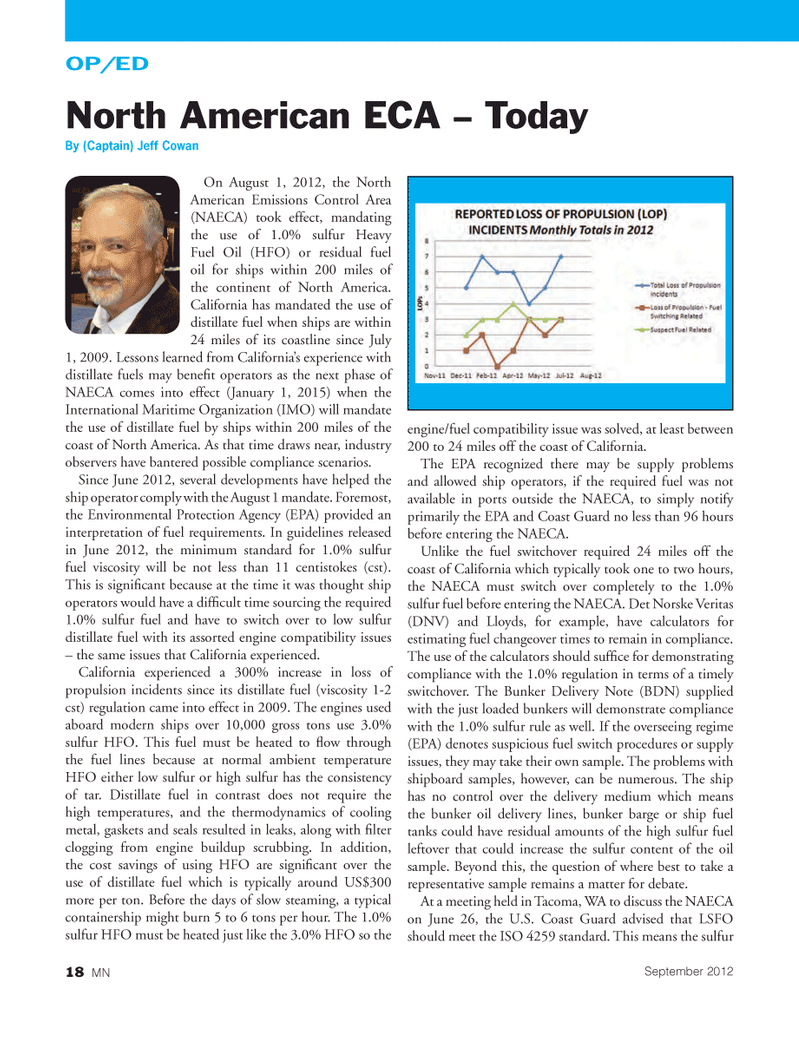
Page 18: of Marine News Magazine (September 2012)
Environment: Stewardship & Compliance
Read this page in Pdf, Flash or Html5 edition of September 2012 Marine News Magazine
OP/EDOn August 1, 2012, the North American Emissions Control Area (NAECA) took effect, mandating the use of 1.0% sulfur Heavy Fuel Oil (HFO) or residual fuel oil for ships within 200 miles of the continent of North America. California has mandated the use of distillate fuel when ships are within 24 miles of its coastline since July 1, 2009. Lessons learned from California?s experience with distillate fuels may bene t operators as the next phase of NAECA comes into effect (January 1, 2015) when the International Maritime Organization (IMO) will mandate the use of distillate fuel by ships within 200 miles of the coast of North America. As that time draws near, industry observers have bantered possible compliance scenarios. Since June 2012, several developments have helped the ship operator comply with the August 1 mandate. Foremost, the Environmental Protection Agency (EPA) provided an interpretation of fuel requirements. In guidelines released in June 2012, the minimum standard for 1.0% sulfur fuel viscosity will be not less than 11 centistokes (cst). This is signi cant because at the time it was thought ship operators would have a dif cult time sourcing the required 1.0% sulfur fuel and have to switch over to low sulfur distillate fuel with its assorted engine compatibility issues ? the same issues that California experienced.California experienced a 300% increase in loss of propulsion incidents since its distillate fuel (viscosity 1-2 cst) regulation came into effect in 2009. The engines used aboard modern ships over 10,000 gross tons use 3.0% sulfur HFO. This fuel must be heated to ow through the fuel lines because at normal ambient temperature HFO either low sulfur or high sulfur has the consistency of tar. Distillate fuel in contrast does not require the high temperatures, and the thermodynamics of cooling metal, gaskets and seals resulted in leaks, along with lter clogging from engine buildup scrubbing. In addition, the cost savings of using HFO are signi cant over the use of distillate fuel which is typically around US$300 more per ton. Before the days of slow steaming, a typical containership might burn 5 to 6 tons per hour. The 1.0% sulfur HFO must be heated just like the 3.0% HFO so the engine/fuel compatibility issue was solved, at least between 200 to 24 miles off the coast of California. The EPA recognized there may be supply problems and allowed ship operators, if the required fuel was not available in ports outside the NAECA, to simply notify primarily the EPA and Coast Guard no less than 96 hours before entering the NAECA. Unlike the fuel switchover required 24 miles off the coast of California which typically took one to two hours, the NAECA must switch over completely to the 1.0% sulfur fuel before entering the NAECA. Det Norske Veritas (DNV) and Lloyds, for example, have calculators for estimating fuel changeover times to remain in compliance. The use of the calculators should suf ce for demonstrating compliance with the 1.0% regulation in terms of a timely switchover. The Bunker Delivery Note (BDN) supplied with the just loaded bunkers will demonstrate compliance with the 1.0% sulfur rule as well. If the overseeing regime (EPA) denotes suspicious fuel switch procedures or supply issues, they may take their own sample. The problems with shipboard samples, however, can be numerous. The ship has no control over the delivery medium which means the bunker oil delivery lines, bunker barge or ship fuel tanks could have residual amounts of the high sulfur fuel leftover that could increase the sulfur content of the oil sample. Beyond this, the question of where best to take a representative sample remains a matter for debate. At a meeting held in Tacoma, WA to discuss the NAECA on June 26, the U.S. Coast Guard advised that LSFO should meet the ISO 4259 standard. This means the sulfur North American ECA ? Today By (Captain) Jeff Cowan 18 MNSeptember 2012MNSept2012 Layout 18-31.indd 18MNSept2012 Layout 18-31.indd 188/30/2012 3:07:13 PM8/30/2012 3:07:13 PM

 17
17

 19
19
